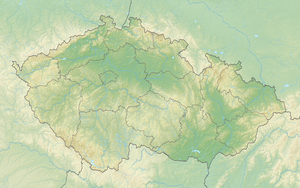Landštejn Castle
| Landštejn Castle | ||
|---|---|---|
|
Landštejn Castle |
||
| Creation time : | Early 13th century | |
| Conservation status: | ruin | |
| Place: | Staré Město pod Landštejnem | |
| Geographical location | 49 ° 1 '25.7 " N , 15 ° 13' 48" E | |
|
|
||
The Landštejn Castle (German Landstein Castle ) is located in the Landštejn district of the Staré Město pod Landštejnem municipality in the Czech Republic .
history
Landstein Castle was built after 1222 at the latest to secure the then troubled Bohemian-Austrian border. It was probably built on the initiative of the Bohemian King Ottokar I Přemysl for strategic reasons opposite the older castle of the same name, which belonged to the Austrian Zöbingern. The Zöbingen castle stood on the site of the later settlement of Markl ( Pomezí ). A trade route ran through the valley between the two castles, connecting Bohemia with Austria and Italy; since 1179 it has formed part of the border between Bohemia and Austria by decision of the emperor Friedrich I. Barbarossa .
The oldest part of the castle is documented from 1231, when the first castle caretaker Hartlieb von Landstein ( Hartlieb z Landštejna ), a Moravian nobleman and castellan from Znojmo , testified to a document that contained the ownership situation in this area and with the the existence of the two castles is documented. While the Austrian castle had the character of an open palatinate , the Bohemian castle Landstein corresponded to a modern, closed castle.
After the Margrave of Moravia and later King of Bohemia Ottokar II. Přemysl became Duke of Austria in 1251, the border running through the valley between the two castles lost its importance. In addition, this branch of the Zöbingen family died out in 1232 and the entire area fell to Bohemia due to the unclear ownership situation.
Around this time the Witigonen gained great importance in the settlement and colonization of South Bohemia. The Landstein family branch , which is said to have been founded by Witiko IV, a son of Witiko von Prčice , acquired the Landstein castle and estate. It is not known in which year the acquisition took place. For the year 1282 Sezima von Wittingau ( Sezima z Třeboně ) is documented as the owner. The most important owner was probably Wilhelm von Landstein , to whom the property passed in 1315.
After the death of Wilhelm's son Litold around 1381, Landstein fell to King Wenzel IV as a settled fief . He left the castle and rule of Landstein to his highest court master, the Austrian nobleman Konrad Kraiger von Kraigk . He undertook to open the castle to the Bohemian kings at any time and granted them a right of first refusal. Konrad's son Lipold was captain of Budweis . Since he was on the side of the Catholics at the beginning of the Hussite Wars , the Hussite army leader Jan Žižka besieged Landstein Castle in 1420. He also burned Lipold's castle and town of Neubistritz , where he captured Lipold's wife Anna von Meseritsch and her daughter Dorothea. Under the Kraiger von Kraigk, Landstein Castle was rebuilt in the first half of the 16th century in the Renaissance style and expanded to include the Palas . The castle fortifications were renewed.
In 1579 Anna von Roupov, née Kraiger von Kraigk, sold the castle and lordship of Landstein to the Austrian lord Stephan von Einzing . He expanded the rule to include more villages and in 1599 sold the property to David Neumayer from Iglau . In July 1618, the imperial general Heinrich von Dampierre besieged Landstein Castle without success. Only his successor Karl Bucquoy succeeded in taking it. Since Gottfried Neumayer was involved in the Bohemian class uprising , he lost his property after the battle of the White Mountain . In 1623 Maximilian Mohr von Lichtenegg acquired the castle and lordship of Landstein, who was followed by the Kuen von Belasy and, from 1668, Humprecht Jan Czernin von Chudenitz . His son Thomas Zacheus sold Landstein to Ferdinand von Herberstein in 1685 . The Herbersteiners held the property until the second half of the 18th century, but had to sell parts of their Landstein estate to their creditors due to excessive indebtedness.
In 1771 a fire caused by lightning destroyed Landstein Castle. After that, the castle was no longer inhabited. Subsequently, parts of the remaining walls were used as building material in the surrounding villages. The last owners were the Austrian Sternbach family, who were expropriated in 1945.
The main wall with two towers and the Romanesque chapel have been preserved from the originally large castle complex. From 1972 security measures followed, followed by an extensive reconstruction. The castle has been open to the public since 1990.
literature
- Joachim Bahlcke , Winfried Eberhard, Miloslav Polívka (eds.): Handbook of historical places . Volume: Bohemia and Moravia (= Kröner's pocket edition . Volume 329). Kröner, Stuttgart 1998, ISBN 3-520-32901-8 , p. 319.
- Wilhelm-Christian Erasmus (ed.): Castles, monasteries and palaces in the Waldviertel, Danube region, South Bohemia, Vysočina and South Moravia regions. Destination Waldviertel GmbH, Zwettl 2007, ISBN 978-3-9502262-2-5 , p. 61 f.
- Lenka Špičákova: Landštejn. Gloriet ve spolupráci se správou státního hradu Landštejn, Libice nad Cidlinou o. J. (2006?), ISBN 80-86644-59-6 .
Web links
Individual evidence
- ↑ http://new.novabystrice.cz/historie/1381-1575 ( page no longer available , search in web archives ) Info: The link was automatically marked as defective. Please check the link according to the instructions and then remove this notice.


